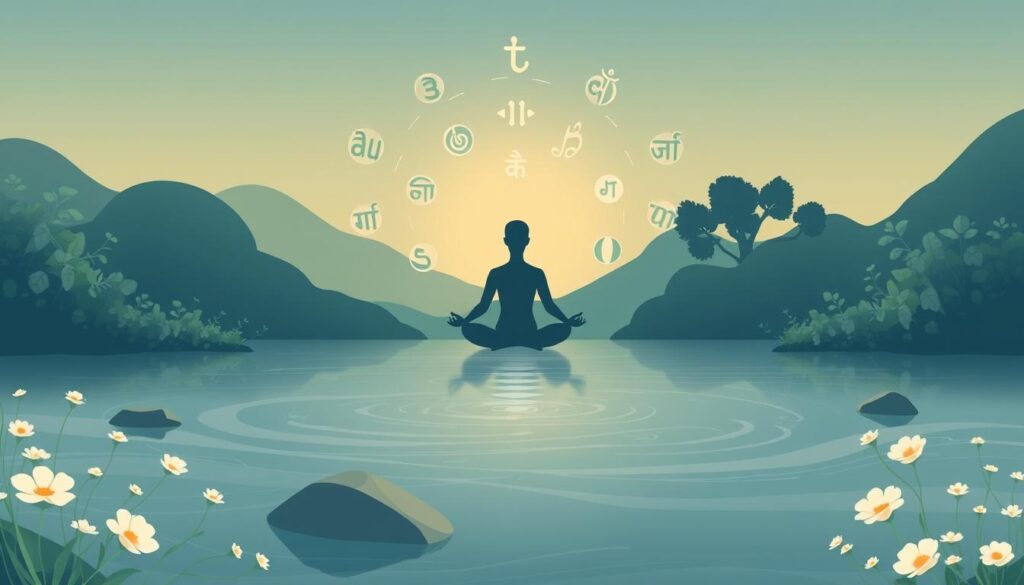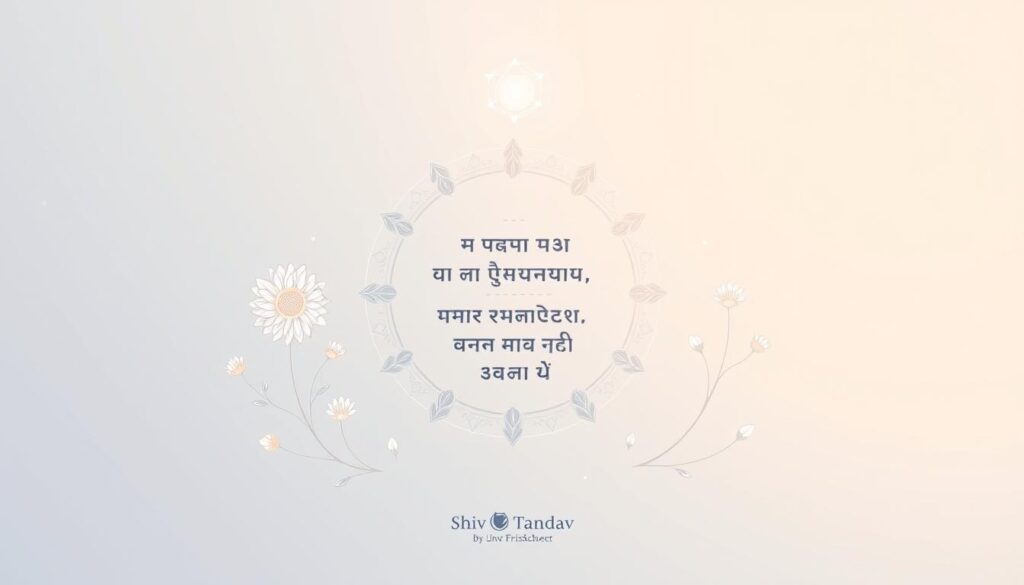
Did you know the ancient Buddhist mantra “Om Mani Padme Hum” has been in temples for over 25 years? This powerful chant is just one of many meditation mantras that can bring deep inner peace and spiritual growth. In this guide, we’ll look at seven revered mantras from different spiritual traditions. We’ll explore their origins, meanings, and the benefits they offer to your meditation practice.
Key Takeaways
- Discover the transformative power of ancient meditation mantras for inner peace and spiritual growth
- Explore the history, meanings, and benefits of seven of the most potent mantras, including Om Mani Padme Hum, Gayatri Mantra, and Ra Ma Da Sa
- Learn how to incorporate these mantras into your daily practice for maximum impact
- Understand the science behind the mind-body-spirit connection of mantra meditation
- Enhance your meditation experience and achieve a deeper state of relaxation and clarity
Understanding the Power of Meditation Mantras

Mantras are sacred chants with deep roots in ancient Vedic and Buddhist traditions. They are powerful tools for changing consciousness, finding inner peace, and connecting the mind and body.
Origins and Historical Significance
In India, mantra meditation has been practiced for thousands of years. Spiritual seekers use these sacred sounds to change their awareness and connect with the divine. Mantras are often Sanskrit phrases or single syllables.
How Mantras Affect the Mind
Mantra meditation creates vibrations that change brainwave activity and consciousness. Studies show it can relax the mind and body. It lowers heart and respiratory rates and blood pressure.
This relaxation can reduce stress, anxiety, and even depression symptoms.
Scientific Benefits of Mantra Meditation
Many studies have shown mantra meditation’s benefits. It improves focus, mood, and overall well-being. It also reduces inflammation, helps sleep, and strengthens the mind-body connection.
The power of meditation mantras is in quieting the mind. They allow for deeper relaxation, self-awareness, and spiritual connection. Whether you’re new or experienced, mantra meditation can be transformative.
Best Mantras for Meditation Practice

Meditation is a powerful tool for achieving inner peace and spiritual growth. At the heart of many meditation practices are top meditation mantras – sacred spiritual chants that can transform the mind and deepen the experience. From the iconic Om Mani Padme Hum to the revered Gayatri Mantra, these effective mantras offer a rich tapestry of benefits for the modern seeker.
One of the most renowned mantras is the Om Gum Ganapatayei Namaha, which invokes the energy of Lord Ganesha to remove obstacles and foster new beginnings. The Ram mantra, on the other hand, is a powerful tool for cultivating strength, courage, and divine protection.
- The Ra Ma Da Sa mantra is renowned for its healing properties, drawing upon the frequencies of the sun, moon, earth, and ether to promote physical, emotional, and spiritual well-being.
- The Kamadeva Mantra is a captivating chant that awakens the energy of love, beauty, and inner radiance.
- The ancient Rudra Mantra, also known as the Tryambakam Mantra, is a profound invocation of the divine masculine principle for transformation and spiritual awakening.
Whether you’re a beginner or an experienced meditator, exploring this curated selection of top meditation mantras can deepen your practice and unlock new realms of self-discovery. Embrace the power of these spiritual chants and embark on a transformative journey towards inner peace and enlightenment.
Om Mani Padme Hum: The Path to Enlightenment

The Buddhist mantra “Om Mani Padme Hum” is a sacred tool for compassion meditation and enlightenment. It comes from Tibetan Buddhism and has been chanted for centuries. It offers deep spiritual benefits.
Meaning and Pronunciation
The mantra is pronounced as “Ohm-Mah-nee-Pahd-may-Hoom.” It means “The jewel in the lotus.” Each syllable has a deep meaning, showing the path to enlightenment.
Benefits and Practice Guidelines
Chanting “Om Mani Padme Hum” purifies negative thoughts and emotions. It leads to inner peace, wisdom, and compassion. It’s suggested to repeat it 108 times, using mala or prayer beads.
“The mantra is believed to have miraculous effects, including healing properties and purification of karma.”
Traditional Uses in Buddhism
In Tibetan Buddhism, the mantra is linked to Avalokiteshvara, the bodhisattva of compassion. It’s used in meditation, rituals, and daily practices. It invokes the energy of this revered figure.
Using the “Om Mani Padme Hum” mantra in meditation can start a journey towards enlightenment. It helps grow wisdom, compassion, and inner peace.
The Sacred Gayatri Mantra

The Gayatri Mantra is a sacred Vedic mantra that calls upon the sun god Savitur for enlightenment. It is known as one of the most powerful mantras for spiritual growth and awakening.
This mantra has a special 24-syllable structure in the Gayatri meter. It’s chanted during the Sandhyavandanam, a daily ritual at dawn, noon, and dusk. It’s also recited during important life events and meditation.
Chanting the Gayatri Mantra boosts concentration and mental discipline. It reduces stress and promotes emotional stability. It helps connect us with higher consciousness, seeking wisdom and divine light.
| Significance of the Gayatri Mantra | Key Facts |
|---|---|
| One of the most powerful and well-known mantras in Hinduism Traditionally taught during the Upanayana ceremony, marking the beginning of Vedic studies Believed to offer protection and benefits at various life stages Considered a tool for spiritual growth and learning, requiring proper initiation | Found in the Rig Veda (3:62:10) Includes the sound Om and the maha vyahritis: bhur, bhuvah, and svah Traditionally recited 108 times using mala beads Recommended practice times are morning and evening |
The Gayatri Mantra is a powerful tool for spiritual illumination and growth. It’s deeply rooted in the Vedic tradition. Its recitation and practice are known for their transformative effects on the mind, body, and spirit.
Om Gum Ganapatayei Namaha: Removing Obstacles

In Hindu beliefs, Lord Ganesha is known as the Remover of Obstacles. He helps people find success and new beginnings. The mantra “Om Gum Ganapatayei Namaha,” or “Ohm Guhn Guh-nuh-puh-tie-yay Nah-muh-huh,” calls upon this beloved god.
Understanding Ganesha’s Energy
Ganesha, with his elephant head, is often the first god worshipped in new starts. His human body and four arms show the blend of physical and spiritual. He is the “Master of the Mind,” symbolizing intelligence and overcoming challenges.
Implementation in Daily Practice
- Chant the “Om Gum Ganapatayei Namaha” mantra 108 times to clear mental and spiritual barriers, inviting Ganesha’s blessings for a fresh start.
- Incorporate Ganesha-inspired products, such as the Whispers of Lord Ganesha Card Deck or Root Chakra candles, to deepen your connection with this powerful energy.
- Meditate on the image of Ganesha, visualizing his benevolent presence removing obstacles and paving the way for your success.
By using the “Om Gum Ganapatayei Namaha” mantra, you can align with Ganesha’s energy. This opens up new possibilities and helps you start your journey with confidence. Let Ganesha’s wisdom guide you through life’s challenges.
Ram: The Mantra of Strength and Protection

Honoring Lord Ram, the Ram mantra is about courage and winning over challenges. It brings a sense of strength and protective energy. This makes it great for courage meditation.
Lord Ram is seen as a symbol of right and wrong in Hinduism. Saying the Ram mantra connects us to our inner strength. It helps us feel brave and strong, especially when things get tough.
“Chanting ‘Shri Ram Jaya Ram Kodhanda Rama’ brings the blessings of courage and valor.”
The Ram mantra helps balance our body’s energy channels. This improves blood flow and keeps us healthy. It boosts our inner strength and ability to handle challenges.
Looking for strength, overcoming fears, or staying strong? The Ram mantra is a powerful ally. It strengthens our courage meditation practice on our spiritual path.
The Healing Power of Ra Ma Da Sa

In the world of meditation mantras, the Ra Ma Da Sa Sa Say So Hung mantra is special. It comes from Kundalini yoga and brings together the sun, moon, earth, and spirit. This mantra helps with physical, emotional, and spiritual health.
Kundalini Yoga Connection
The Ra Ma Da Sa Sa Say So Hung mantra is a key part of Kundalini yoga. It helps move kundalini energy and balances the brain’s hemispheres. Each syllable connects to a chakra, guiding healing and alignment through chanting.
Physical and Emotional Benefits
- This mantra calms and grounds, reducing stress and bringing peace.
- It boosts the immune system, heals physical issues, and connects us with nature.
- Emotionally, it releases blocked energies, heals wounds, and promotes balance and self-acceptance.
Looking for physical, emotional, or spiritual healing? The Ra Ma Da Sa Sa Say So Hung mantra is a powerful tool. Add it to your daily routine and see the healing it can bring.
Kamadeva Mantra for Inner Beauty

The beauty mantra known as the Kamadeva Mantra is special. It’s an ancient Sanskrit chant that unlocks inner beauty and attractiveness. The chant is “Om Kamadevaya Vidmahe, Pushpabaanaay Dheemahi, Tanno Ananga Prachodayat.”
Kamadeva is the God of love, desire, and sexuality. He’s often shown with his consort Rati. This mantra is believed to bring love, desire, and passion to those who use it.
An ancient temple in Assam, India, worships Kamdev and his brother Madan. This shows the cultural importance of Kamadeva.
The mantra teaches that true beauty is in actions and words. Chanting it can bring self-acceptance, confidence, and inner light. It’s especially helpful in a world where intimacy and passion are often lacking.
“Chanting Kamadeva Mantras is believed to help heal sexual problems and bring back ex-partners, while also promoting self-love and balancing sexual energy.”
To chant the Kamadeva Mantra, set intentions, use a Kamadeva picture, light a lamp, and visualize. Chant 108 times, best during Brahma Muhurta or Sandhya. Practice for 40 days to see results.
In a world focused on looks, the Kamadeva Mantra reminds us of true beauty. It’s a journey of self-love and inner light. It builds lasting confidence and magnetism, beyond looks.
The Ancient Rudra Mantra

The Rudra or Tryambakam mantra is a key part of Vedic healing mantras. It’s known for protection, health, and spiritual growth. This chant comes from the Rig Veda and has been used for centuries to seek divine blessings and overcome challenges.
Traditional Applications
The Rudra Mantra, “Om Tryambakam Yajamahe Sugandhim Pushti-Vardhanam Urvarukamiva Bandhanan Mrityor Mukshiya Maamritat,” is deeply rooted in Vedic and tantric traditions. It’s believed to cleanse the mind and body, removing bad energies and bringing spiritual peace. Many use it during illness or medical procedures, hoping for its healing and protective effects.
Modern Healing Properties
- The Rudra Mantra helps balance the autonomic nervous system. It improves heart rate variability and boosts the immune system.
- Practicing this mantra regularly can lower cortisol levels, the main stress hormone. This helps manage stress and improve emotional health.
- Chanting this Vedic healing mantra leads to deep relaxation. It increases alpha and theta brain waves, which are linked to meditation and mindfulness.
- The protection chant of the Rudra Mantra builds inner strength, resilience, and spiritual grounding. It’s a valuable tool for longevity meditation.
As science delves into the effects of mantras, the Rudra Mantra stands out. It’s a captivating and potentially transformative practice for those seeking holistic well-being.
Choosing the Right Mantra for Your Practice

Finding the right mantra for meditation can be life-changing. Personalized mantras that match your spiritual goals and emotional needs can make your practice deeper. They lead to more inner peace. The goal is to find a mantra that truly speaks to your heart and mind.
Mantras fall into three categories: Bija (seed), Saguna (with form), and Nirguna (without form). Each type has its own purpose. It’s crucial to think about your meditation goals and what you prefer when picking a mantra.
- Bija mantras, like “Om,” help focus the mind and reach higher states of consciousness.
- Saguna mantras, such as “Om Mani Padme Hum,” call upon specific deities or energies to bring about qualities like compassion.
- Nirguna mantras, often simple phrases or affirmations, quiet the mind and promote inner harmony.
Finding the right mantra might come from intuition, a teacher’s guidance, or trying out different ones. It’s wise to stick with a mantra for a while to see its full impact before looking for a new one.
“When you have a mantra that really resonates with you, it can become a powerful tool for spiritual alignment and meditation goals.”
The best personalized mantras are those that fit your unique needs and tastes. By exploring various mantras and listening to your inner voice, you can find the perfect mantra for your meditation journey.
Essential Tips for Mantra Pronunciation

Getting the pronunciation right is key to unlocking meditation mantras’ full power. Whether you’re new or looking to deepen your practice, learning Sanskrit pronunciation can boost your experience.
Start by listening to real audio recordings of mantras by experienced practitioners. Notice the vibration and rhythm of each syllable. Try to match the tones as closely as you can. Begin slowly, focusing on each sound, and then speed up as you get better.
- Get used to Sanskrit’s unique sounds, like the rolled “r” and the “sh” and “ch” sounds.
- Try different volumes and tones to find what feels right for you.
- Practice regularly. The more you do it, the easier it gets.
The power of mantra meditation comes from the vibration it creates. While perfect pronunciation is great, your intention and consistent practice are more important. Enjoy the journey and let mantra recitation transform you.
“The repetition of a mantra is not mere mechanical recitation, but a conscious effort to align one’s consciousness with the cosmic vibration.”
– Swami Sivananda
Creating a Sacred Space for Mantra Practice

Creating a dedicated meditation space is key for a deep mantra practice. This space should be calm and welcoming, helping you on your spiritual path. A sacred altar can connect you deeply with mantras’ power.
Setting Up Your Meditation Area
Find a quiet, clean spot in your home for mantra practice. Pick a place that feels right to you, with good light, comfy seating, and privacy.
Make your meditation space special. Use a table or bookshelf as your sacred altar. Choose wood or bamboo for a natural feel.
Recommended Tools and Props
- Meaningful images, statues, or symbols that represent your spiritual guides or deities
- Candles, incense, or essential oils to set the mood and enhance the atmosphere
- Mala beads or other mantra accessories to support your practice
- Inspirational books, journals, or other items that hold personal significance
- A comfortable cushion or mat for seated meditation
Set up your sacred altar in a way that feels right to you. Follow a theme that matches your spiritual beliefs. Keep your space tidy, as its state affects your inner peace.
Having a special sacred space for mantra practice creates a calm place for your mind. Let this space be a sanctuary for your spiritual growth.
Common Challenges in Mantra Meditation
Mantra meditation brings many benefits, but it also has its hurdles. One big challenge is when our minds wander. As we say the mantra, our thoughts often stray to other things. This makes it hard to stay focused.
Finding the right mantra can also be tough. There are so many sacred sounds to choose from. Plus, keeping a steady rhythm while reciting the mantra can be tricky, especially for newbies.
Some people worry about losing touch with reality during mantra meditation. But, this practice is actually grounding and helps you stay centered. It can be adjusted to fit your beliefs and needs.
To get past these challenges, patience and persistence are key. Try focusing on your breath or using mala beads to keep your mind on track. Remember, the more you practice, the better you’ll get at staying focused.
“The real meditation is how you live your life.”
By facing and solving these common issues, you can make your mantra meditation practice stronger. This unlocks the deep, ancient wisdom of these sacred sounds.
Incorporating Mantras into Daily Life

Living a mantra lifestyle is more than just meditating. Mantras can change your day, making your everyday spirituality and mindful living stronger. Add these powerful tools to your daily life to see how they can improve your mind, body, and soul.
Begin your day with a positive affirmation mantra. Write it down or keep it as a reminder. Say it quietly while you get ready or out loud with your morning coffee. This simple act can help you stay focused on your goals and keep a mantra lifestyle all day.
Use mantras in your daily tasks to find stress relief and grounding. Say a calming mantra on your way to work, in line, or when you’re stressed. These sacred sounds can quiet your mind, bringing peace and clarity.
- Use mantras as a tool for mindfulness during daily tasks, such as washing dishes or taking a walk.
- Chant mantras silently or aloud to enhance your connection with the present moment.
- Experiment with different mantras to find the ones that resonate most with your personal needs and preferences.
By adding mantras to your daily life, you can deepen your everyday spirituality and mindful living. This way of using mantras can lead to more peace, emotional balance, and spiritual growth.
| Mantra Benefits | Statistics |
|---|---|
| Reduced Stress and Anxiety | Regular mantra chanting can lower blood pressure and boost immune function. |
| Improved Mental Clarity | Mantra meditation can initiate intense focus and aid in improving attention span. |
| Enhanced Spiritual Connection | Mantras have been explored as powerful personal growth and spiritual development tools for centuries. |
“Mantras can help reduce stress, promote inner peace, enhance creativity, increase self-awareness, and cultivate positive thoughts.”
Advanced Mantra Meditation Techniques

For those looking to deepen their spiritual practice, advanced mantra meditation techniques offer a path to profound inner transformation. By exploring extended mantra retreats, combining mantras with breathing exercises, or incorporating visualizations, meditators can unlock new realms of deep meditation, mantra mastery, and spiritual awakening.
One powerful approach is to immerse oneself in a mantra retreat. Here, one dedicates extended periods to the focused repetition of a single sacred sound or phrase. This extended practice allows the mind to fully surrender to the mantra, fostering a deeper energetic connection and unveiling the profound philosophical meanings behind the words.
Another advanced technique involves syncing mantra recitation with the breath. This creates a harmonious union of mind, body, and spirit. By aligning the mantra with the natural rhythm of inhalation and exhalation, practitioners can achieve heightened states of focus and inner peace.
For the truly adventurous, incorporating visualization practices can take mantra meditation to new heights. Meditators may envision the mantra’s sacred syllables or the deities associated with them. This further amplifies the transformative power of the practice.
Those seeking to deepen their mantra mastery may also explore the traditional art of Sanskrit chanting. Learning to pronounce the ancient mantras with precision and resonance can transport the practitioner into a more immersive, authentic experience of these timeless spiritual tools.
Ultimately, the path of advanced mantra meditation is one of patience, dedication, and a willingness to embark on a profound journey of spiritual awakening. By embracing these practices, individuals can unlock the full potential of these sacred sounds and forge a profound connection with the divine within.
| Mantra Practice | Benefits | Tips |
|---|---|---|
| Mantra Retreat | Deeper energetic connection, Unveiling philosophical meaning | Dedicate extended periods to focused mantra repetition |
| Mantra with Breath | Heightened focus, Inner peace | Align mantra recitation with natural rhythm of breath |
| Mantra Visualization | Amplified transformative power | Envision sacred syllables or associated deities |
| Sanskrit Chanting | Authentic, immersive experience | Learn precise pronunciation of ancient mantras |
“The path of advanced mantra meditation is one of patience, dedication, and a willingness to embark on a profound journey of spiritual awakening.”
Conclusion
Mantra meditation is a powerful tool for spiritual growth and inner peace. Regular practice can lead to profound personal transformation. It allows individuals to tap into their deepest wisdom and discover greater harmony within.
By choosing mantras that resonate with you and staying consistent, you can start a transformative meditation journey. This journey offers profound mantra benefits for both your physical and mental well-being.
Whether you’re drawn to Sanskrit mantras or find solace in other faith traditions, mantra meditation unlocks your fullest potential. Embrace the journey of self-discovery. Let the timeless wisdom of these sacred sounds guide you towards greater clarity, emotional balance, and spiritual awakening.
As you explore mantra meditation, approach it with an open mind and a willingness to learn. The path may not always be easy, but the rewards are truly transformative. Embrace the challenges, trust the process, and let the mantra benefits unfold as you deepen your spiritual growth and connection to the present moment.
FAQ
What are the benefits of mantra meditation?
Mantra meditation can help reduce stress and improve focus. It also boosts overall well-being. Studies show that mantras can change brain waves, leading to deep relaxation and peace.
How do I choose the right mantra for my meditation practice?
Think about your life situation and what you want from meditation. Try different mantras to find the ones that feel right for you and your goals.
How do I properly pronounce mantras?
Good pronunciation makes mantras more powerful. Listen to real recordings and practice slowly. Focus on the sound and rhythm of each syllable. Remember, it’s the intention and regular practice that matter most, not perfect pronunciation.
How do I create a sacred space for mantra meditation?
Choose a quiet, clean spot for meditation. Add items like cushions, mala beads, candles, or incense to create a special atmosphere. Set up a personal altar with objects that mean something to you. Make sure the space is comfy and helps you focus and relax.
How can I overcome challenges in mantra meditation?
You might face distractions, trouble focusing, or feel awkward. Try focusing on your breath, visualizing the mantra, or using mala beads. Remember, being consistent and patient will help you get better over time.
How can I integrate mantras into my daily life?
Use mantras in your daily routine, not just during meditation. Say them during stressful times or as morning affirmations. Write them down, put them up as reminders, or chant them silently while you’re on the go. Using mantras all day can make them more powerful.
What are some advanced mantra meditation techniques?
Try longer mantra retreats, mix mantras with breathing, or add visualization. Learn about the deeper meanings of mantras for a stronger spiritual connection. You could also learn traditional Sanskrit chanting for a richer experience.

